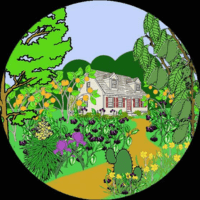24 fruiting trees, herbs and other garden plants purchased for HEPPY™ in 2020!
Overview of our BIG 2020 purchase!
Fruiting trees, herbs and garden plants were gathered in ONE week! 24 plants in all! they’re all EASY to grow in zone 7. Some fruiting trees are considered ‘exotic’ fruits (see how ‘exotic’ fruiting trees and NOT unusual and, are easily grown 😉
Of the 24 plants, 19 produce edible fruits 😉 BUT, 2 may bloom too early for zone 7 🙁 They’ll grow just fine but bearing fruit may be a challenge. We’re always learning here at HEPPY™.
Find the plant you’re interested in below and keep learning! Our YouTube video featuring all 24 plants is here.
Buy fruiting trees, herbs & garden plants from these excellent family-owned nurseries!
I searched for family-owned nurseries that ALSO sold unusual fruiting trees, fruiting shrubs, and more. I drove across the States so there a LOT to choose from.
I found two EXCELLENT nurseries:
1. Natives of Texas
2. Willis Orchard
*** We make no commission from these mentions
*** Click here for a list of nurseries who sell fruiting trees and shrubs, herbs and cool garden plants!
Webpage content
My “girls” are divided between trees/shrubs that produce edible fruit or herbs, and garden plants with interesting features!
________________________________________
see our list of 400 edible plants
YouTube channel (please subscribe)
19 Fruiting Trees and Herbs — easy to grow in zone 7
#1 Mason's Superberry Mayhaw
About the Mason's Superberry Mayhaw
aka, Texas Superberry, May Hawthorn, Apple Hawthorn.
the Mason’s Superberry Mayhaw is a cultivar of the western mayhaw (Crataegus opaca). the eastern mayhaw (Crataegus aestivalis) produces cultivars also. Mayhaw are native to North America.
Mayhaw Fruit
Mayhaw is a tart fruit (generally). HEPPY™ plans on juicing the fruit with apples or other sweet fruits.
traditionally, Mayhaw fruit is made into a jelly, jam or syrup (see, Making Mayhaw Jams and Jellies). it can be used in fruit pies, cakes and pastries. served alongside game meats. also, Mayhaw can be used to produce wine.
As a Fruiting Tree
Mason’s Superberry Mayhaw is an upright spreading tree that blooms in mid-to-late February; fruit ripens in late April. Mayhaw fruit is considered large (1/2″ to 3/4″). the fruit has very dark red skin with pink flesh. fruit firmness is excellent. the fruit will hang on the tree longer than other cultivars. its early bloom will decrease fruit production as you move northward in plant zones.
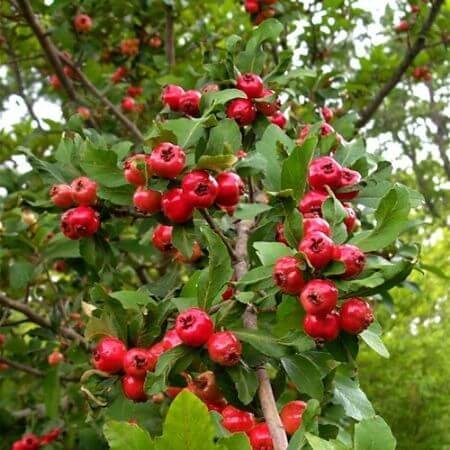
pic possibly by Helen Rice via Pintrest
Caution
growing in zone 7 doesn’t mean fruiting in zone 7. heads up: some Mayhaw cultivars flower REDICULOUSLY early. they bloom in late February, including the Mason’s Superberry Mayhaw! if you’re in zone 7 or 8, look at the ‘Big Red’ Mayhaw variety. HEPPY is a ‘no BS’ site — we’re here to share our successes and the ‘ops, missed that one’ experiences.
#2 White Pomegranate

pic by specialtyproduce.com
Types of White Pomegranate
Surh-Anor and Utah Sweet Pomegranates are sweet varieties. Utah Sweet Pomegranate has “seeds notably softer than … other standard cultivars.”
then there are pinkish colored Pomegranates. Eversweet Pomegranate has a pink skin and pink fruit. research cultivars for YOUR desired ‘fit’.
About the White Pomegranate
the specific cultivar of our White Pomegranate is not known 🙁
Punica granatum is the scientific name of all Pomegranates. there are more than 500 named cultivars. in general, White Pomegranates are sweet, and sweeter than the Red Pomegranates.
Pomegranate Fruit
White Pomegranate fruit is very sweet and juicy.
Pomegranate fruit has a whitish-pink colored outer husk (pericarp). everything inside the husk is edible. inside are many juicy berries (arils) and a white membrane (mesocarp).
the arils are transparent white. inside the arils are seeds you eat — inconspicuous & tasteless seeds that make a little crunch when eaten.
As a Fruiting Tree (Shrub)
is the Pomegranate a fruiting tree or fruiting shrub? i’ve never seen a Pomegranate tree taller than 10′. starting at ground-level, they are multi-trunked. the multi-trunks grow erect 7-10′. so the Pomegranate has a tall shrub-like appearance. this is a LOW maintenance, drought tolerant fruiting tree.
White Pomegranate tree fruit ripen in early September.
Some cultivars grow in zone 6 (Makedonia Red and Kazake Hardy Pomegranates)! other types of Pomegranates grow in zone 8 (or warmer). our White Pomegranate is listed as zones 7-10.
*** PROBABLY not affected by early frost (zone 7 ALERT ;). if fruit develops late-year (eg, Sept), then it’s very likely the tree will bloom AFTER the risk of frost (the risk of frost destroying blooms).
#3 Hop Tree
About the Hop Tree
aka, Wafer Ash, Common Hoptree, Pallid hoptree.
Ptelea trifoliata is the scientific name. Hop Tree is native to North America.
Hop Tree Fruit
well, only if you’re VERY hungry will you eat the fruit :(. the ‘fruit’ is a thin wafer with a very bitter flavor.
across the internet you read, “though it is eaten by young children.” the uncited remark originates from Ethnobiological Studies of the American Southwest. the San Felipe Native American Tribe ate the fruit. in the Studies it was noted, “Fruits commonly eaten by children.”
US colonialists used the fruit as a substitute for hops. currently, a few US craft breweries are experimenting with Hop Tree fruit (as a hops substitute).
MANY remarks about it’s medicinal qualities. MUCH more to learn!
As a Fruiting Tree
a HIGHLY adaptive tree. LOW maintenance. can be grown in full sun or shade, and can be used as a hedge or grown as a tree. grows 10′-15+’ tall, no serious insect or disease problems. the fruiting tree grows from Arizona to northern Quebec. grows in plant zones 4-9.

pic by SEWilco & Eric Hunt via Wikipedia
#4 Texas Mulberry
Types of Mulberry
ONLY two species of Mulberry are native to North America: the Red Mulberry (Morus rubra) and the Texas Mulberry (Morus microphylla). Please plant these NATIVE species.
conversely, please AVOID the White Mulberry (Morus alba) and Paper Mulberry (Broussonetia papyrifera). they are non-native invasive mulberry trees.
About the Texas Mulberry
aka, Littleleaf Mulberry, Mountain Mulberry, Mexican Mulberry, Dwarf Mulberry.
Morus microphylla is the scientific name of this specific Mulberry tree. Texas Mulberry is native to North America.
Here’s our full Mulberries Plant Guide
YouTube Playlist for Mulberries
Texas Mulberry Fruit
i’ve read that the Texas Mulberry fruit is sweet and another source says it’s sour. the Apache, Chiricahua, Mescalero & Yavapai Native Americans ate the fresh fruit. the Texas Mulberry fruit is shaped much like a raspberry / blackberry.
As a Fruiting Tree
fruiting tree or fruiting shrub? like the Pomegranate, this tree CAN BE is multi-trunked. unlike the Pomegranate, the Texas Mulberry tends to branch sideways as well as upward. so it spreads in a dome shape.
this is a LOW maintenance, drought tolerant fruiting tree. grows in plant zones 5-9.
pruning Mulberry Trees. it’s best to prune in winter to avoid it ‘bleeding’ sap.
fertility of the Texas Mulberry tree is odd. it’s described as not self-fertile, as is our ONE Red Mulberry. however, our one Red sets fruit. perhaps the male is needed if seeds are desired in the fruit. there’s more to learn.
don’t make a mess! ;). this is not an ideal fruiting tree near a sidewalk, where cars are parked, etc. the fruit stains. give her space.
#5 Texas Persimmon
About the Texas Persimmon
aka, Mexican Persimmon, Black Persimmon, Manzano, Chapote, Chapote Prieto.
Diospyros texana is the scientific name of this specific persimmon. Texas Persimmon is native to North America.
Here’s our full Persimmon Plant Guide
YouTube Playlist for Persimmon
Texas Persimmon Fruit
black or dark purple skin and fruit, this persimmon is unlike any other persimmon. fruit size is rather small at 1/2″ (13mm) to 1 1/2″ (38mm). the flavor is described as, “something like a prune, but less tart and more sugary….”
As a Fruiting Tree
the Diospyros texana (Texas Persimmon) is VERY different from its Diospyros cousins, Diospyros virginiana (American Persimmon) and Diospyros kaki (Asian Persimmon).
the Texas Persimmon this is a multi-trunked fruiting tree. more vase-like in shape. the leaves are very different — much smaller and more of them. it’s leaves stay on the tree well into winter. also, the Texas Persimmon is a slower growing tree. the tree can reach 40′ but i’ve not seen one more than 15′. it has a high heat and drought tolerance. grows in plant zones 7-9.
#6 Loquat

pic by selectree.calpoly.edu & DeLorenzo Inc., M. Ritter and J. Reimer
Types of Loquat
two websites show some of the many varieties:
1. Purdue University’s Center for New Crops & Plant Products (NewCROP)
2. California Rare Fruit Growers’ Loquat webpage.
About the Loquat
aka, Japanese Medlar, Japanese Plum, Chinese Plum, Pipa (China). Nespolo (Italy).
Eriobotrya Japonica is the scientific name. Indigenous to southeastern China, it’s been cultivated in Japan for over 1,000 years.
Loquat Fruit
Loquat fruit are orange, yellow or white (and variations of those hues). Orange, yellow or white colored fruit-skin and flesh. white seems less common than orange-hued fruit.
the Loquat fruit reminds me of an Apricot fruit (shape, color and flavor) — Loquat is a little smaller and grows in clusters. each fruit contains three to five large brown seeds.
As a Fruiting Tree
Loquat fruiting trees grow like a shrub or small tree, with a rounded crown. the leaves are VERY ornamental. the Loquat’s broad leaves are large and dark green. leaves are glossy on the ‘top’ side and underneath, a little hairy. small, fine hairs. and it’s an evergreen!
LOW maintenance: VERY drought resistant once established; little pruning; some varieties are self-pollinating; they grow in zones 7-10 BUT some varieties appear to want no colder than zone 8.
Caution
growing in zone 7 doesn’t mean fruiting in zone 7. heads up: “flowers are borne in fall or early winter” (California Rare Fruit Growers). flowering between September and January does NOT coinside zone 7 growing season. HEPPY™ is up to the challenge and has some ideas; in the meantime, we’ll have a damn-pretty Loquat tree 😉 also, finding the Loquat tree that produces the latest-blooming flower is an option. stay tuned!
#7 Satsuma Plum
About the Satsuma Plum
Prunus salicina is the scientific name. the ‘cultivar’ is Satsuma.
the family of Prunus salicina are commonly called the Japanese plum or Chinese plum because it originates in China.
Satsuma Plum Fruit
the Satsuma Plum fruit is large, dark, solid red skin, and dark red flesh. the fruit’s flesh is firm.
increase fruit production by planting a pollinator next to the Satsuma Plum tree. she’s self-pollinating but fruit production is increased by planting one other variety of Prunus salicina next to her.
As a Fruiting Tree
the Satsuma Plum tree is upright, reaching 10-12′. a healthy tree in full sun will produce many white flowers. can be very showy.
zone 4 is it’s limit so she’ll “sweat” in zone 7! the Satsuma Plum tree is hardy to -30°F. Satsuma Plum needs 300 Chill Hours. zone 7, Maryland, gets between 1400-1600 Chill Hours.
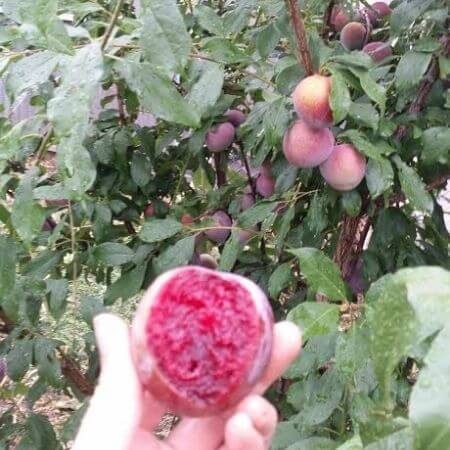
pic by edibleadelaide.com
#8 Methley Plum
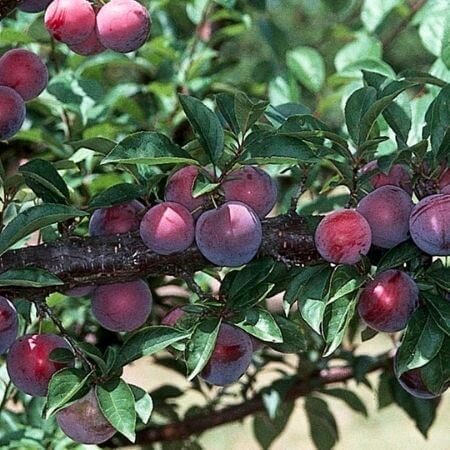
pic by mygardenlife.com
About the Methley Plum
Prunus salicina is the scientific name. the ‘cultivar’ is Methley.
the family of Prunus salicina are commonly called the Japanese plum or Chinese plum because it originates in China.
Methley Plum Fruit
the Methley Plum fruit is medium in size, with red-purple skin and flesh. hopefully, the fruit’s flesh is firm.
increase fruit production by planting a pollinator next to the Methley Plum tree. she’s self-pollinating but fruit production is increased by planting one other variety of Prunus salicina next to her.
As a Fruiting Tree
the Methley Plum is much like the Satsuma Plum: an upright tree, reaching 10-12′. in full sun, she’ll produce many white flowers. can be very showy.
UNlike the Satsuma Plum, zone 5 is the Methley Plum tree’s limit. the Methley Plum tree is hardy to -15°F. Methley Plum needs 250 Chill Hours. zone 7, Maryland, gets between 1400-1600 Chill Hours.
#9 Chickasaw Plum
About the Chickasaw Plum
aka, Watson’s Plum, Hally Jolivette Cherry, Sand Plum, Sandhill Plum, Sand Hill Plum, Mountain Cherry.
Prunus angustifolia is the scientific name. Chickasaw Plum is native to North America.
Here’s our full Plum Plant Guide
A List of all 15 wild plum trees of North America
Chickasaw Plum Fruit
some trees bear flavorful fruits and others have bitter fruits. ripe fruits are small ( 1/4″ to 1/2″). however, all fruiting trees produce larger fruits when fruits are thinned. the fruit’s skin is thin, and colored red, orange-red or yellow. the Chickasaw Plum fruit is golden colored.
the Comanche Native American Indian tribe ate Chickasaw Plum fresh and used it as winter food (Native American Ethnobotany database).
As a Fruiting Tree
this fruiting tree can grow as a single trunk and upright, or shrub-like. it is a thickly branched tree.
an upright growing plum tree may reach 20′. remove root suckers if you desire a well shaped tree. in other conditions, the Chickasaw Plum forms extensive thickets or colonies due to suckering.
generally, blooms appear before the leaves. the Chickasaw Plum blooms in March-April. she grows in plant zones 5-9 and require 250-300 Chill Hours.
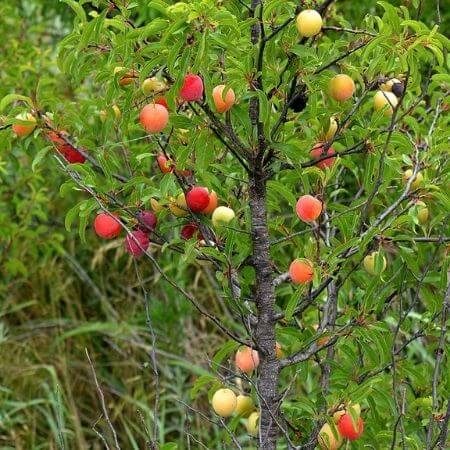
pic possibly by Ted Lee Eubanks' Fermata via Pintrest
Chickasaw Plum and Wildlife
the Chickasaw Plum provides habitat for many birds. it provides food, nesting and shelter from heat. birds that use the Chickasaw Plum for habitat include: Northern bobwhites (Colinus virginianus); brown thrashers (Toxostoma rufum), northern mockingbirds (Mimus polyglottos) and gray catbirds (Dumetella carolinensis); field sparrow (Spizella pusilla), Bell’s vireo (Vireo bellii), and loggerhead shrike (Lanius ludovicianus); painted bunting (Passerina ciris); and lesser prairie-chickens (Tympanuchus pallidicinctus).
#10 American Plum
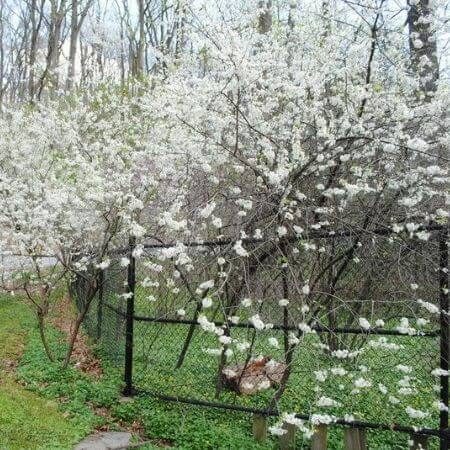
pic by garden.org
About the American Plum
aka, American Wild Plum, Wild Plum.
Prunus americana is the scientific name. American Plum is native to North America.
Here’s our full Plum Plant Guide
A List of all 15 wild plum trees of North America
American Plum Fruit
i’ve enjoyed eating the American Plum fruit. small fruit (1″ round) with light red thin skin. lush and juicy fruit. hint of tart mixed with sweet. very tasty. it’s a prolific fruiting tree.
As a Fruiting Tree
this plum tree is sprawling. it’s growth is not uniform. it’s branches and limbs intertwine. and so it’s ideal for a fence line, or to prevent stream bank erosion.
it forms a thicket (suckers). consequently, the American Plum is ideal for “bird nesting, loafing, and roosting, and animal loafing and bedding” (USDA/PLANTS database).
the American Plum tree grows from Northern Quebec to Northern Mexico, and across North America (East/West). plant zone 3-8.
it is a HIGHLY adaptive tree.
American Plum and use by Native Americans
at least 19 Native American tribes use/used the American Plum Tree for food and medicine. Apache, Cherokee, Cheyenne, Chippewa, Crow, Dakota, Iroquis, Isleta, Kiowa, Lakota, Meskwaki, Mohegan, Navajo, Ojibwa, Omaha, Pawnee, Ponca, Rappahannock, and Winnebago. fresh or dried fruit, for respiratory or urinary aid or, for ceremonial medicine. the American Plum Tree is a HIGHLY useful tree.
#11 Creek Plum
About the Creek Plum
aka, River Plum, Hog Plum, Wild-goose Plum.
Prunus rivularis is the scientific name. Creek Plum is native to North America.
Here’s our full Plum Plant Guide
A List of all 15 wild plum trees of North America
Creek Plum Fruit
true to native Plum Tree species, the fruit varies from Creek Plum tree to Creek Plum tree. the plum fruit is described as “A plum with an excellent flavour. The fruit is usually quite tart and not so well flavoured as Prunus angustifolia[Chickasaw Plum].“
As a Fruiting Tree
the Creek Plum fruiting tree as a sprawling tree. like the American Plum tree, it’s growth is not uniform. it’s branches and limbs intertwine. and so it’s ideal for a fence line, or to prevent stream bank erosion.
it forms a thicket (suckers). consequently, this plum tree is ideal for “bird nesting, loafing, and roosting, and animal loafing and bedding” (USDA/PLANTS database).
the Creek Plum tree grows in warmer regions. plant zone 7-10.
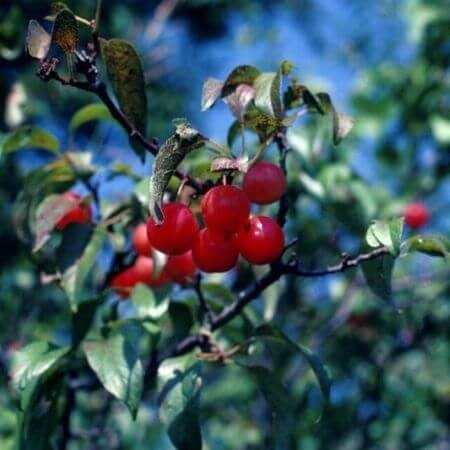
pic by aggie-horticulture.tamu.edu
#12 Mexican Plum
About the Mexican Plum
Prunus mexicana is the scientific name. Mexican Plum is native to North America.
Here’s our full Plum Plant Guide
A List of all 15 wild plum trees of North America
Mexican Plum Fruit
we’ve not had the pleasure of eating these plums. i found the following from two excellent sources.
1. edible plums (to 1” diameter) emerge yellow but ripen on the tree from July to September to rose, lavender or purple.
2. the flesh is thick and juicy, but of varying palatability.
As a Fruiting Tree
Mexican fruiting plum trees do not sucker. they grow upright, as a single trunk tree. this plum tree grows to 15-20 feet high. it’s shape and height is much like a cultivar plum tree.
remove root suckers if you desire a well shaped tree.
blooms appear between April and May — before or after the leaves appear. it grows from Northern Mexico to Wisconsin. she grows in plant zones 6-8. it’s likely to grow in warmer zones (than zone 8).
#13 Passion Flower
About the Passion Flower
aka, Purple Granadilla, Purple Passionfruit, Passion Fruit, Passion Fruit Vine.
Passiflora edulis is the scientific name. Passiflora edulis is native from southern Brazil through Paraguay to northern Argentina.
there’s about 550 species of Passiflora. we currently grow Passiflora incarnata, which is native to North America.
Passion Flower Fruit
Passion Flower fruit varies. some varieties are sweeter than others. we’re NOT entirely sure what our ‘girl’ will produce.
in general, the fruit is similar to a Pomegranate. Passion Flower fruit has a leathery exterior (Pomegranate has a harder exterior) and edible berries inside. passion fruit berries are a little smaller than the Pomegranate’s berries. the edible berries can be easily pulled-out in segments and eaten on-the-spot!
we eat fruit from our Passiflora incarnata after it’s fallen to the ground. fruit that’s fallen to the ground is sweet. we found that Passion Flower fruit picked from the vine has a tart overtone.
Passion Flower is a prolific producer.
As a Fruiting Vine
BE CAREFUL. if Passiflora edulis is like her ‘cousin’, Passiflora incarnata, then this girl will spread fast. Passion Flower roots spread underground (“rhizomes”) and they spread fast. this especially true in great soil. we have to publish a vid on this!! (please subscribe to our YouTube channel!). the rhizomes are tender & fragile BUT unless the roots are contained in some manner, the roots will spread through a space.
trellising is important. we have our Passiflora incarnata growing up a 4′ high rectangular frame with wire mesh across the top. the vine grows through the mesh, she gets a lot of sun, and the fruit hangs down beautifully.
in zone 7, the Passion Flower vine die. the roots are fine. the Passion Flower vine will re-emerge in the spring.

pic by Amazon.com, Bountiful Garden Nursery
Passion Flower Blooms
Passion Flower blooms are SPECTACULAR. what an amazing flower to grow in zone 7.
blooms are large and brightly colored, with unusual formations within the bloom. there’s nothing like the Passion Flower bloom. blooms are up to 3″ wide!
blooms are fragrant! pick a flower and drop it into a glass of water. after of loosing fruit if you pick the blooms? DON’T because this a prolific bloomer.
Passion Flower blooms is a host plant for several butterflies, including the gulf fritillary.
other than controlling it’s roots from unwanted spread, this is an AMAZING fruiting vine.
#14 Rosemary

pic by finegardening.com & Margalob via Wikipedia
Rosemary and Medicinal Qualities
Rosemary has profound medicinal qualities:
“Rosmarinus officinalis is constituted by bioactive molecules, the phytocompounds, responsible for implement several pharmacological activities, such as anti-inflammatory, antioxidant, antimicrobial, antiproliferative, antitumor and protective, inhibitory and attenuating activities.”
there are MANY medical publications on PubMed regarding the medicinal qualities of Rosemary.
About the Rosemary
Rosmarinus officinalis is the scientific name. I see Salvia rosmarinus as the revised scientific name but could not confirm the origin (origin of the statement or origin of the change).
it’s a Mediterranean plant. Rosemary was first mentioned on stone tablets, 5000 BC. Greeks and Romans mentioned it. by 220 AD it’s presence was documented in China.
Rosemary as an Herb
fresh or dried, Rosemary leaves are used in many ways. as flavoring in stews, breads, stuffing, vegetables, herbal butters, vinegars or olive oil. flavor to meats or fish.
make tea from the fresh or dried leaves.
also, use leaves, branches or flowers in sachets, or in perfumes, soaps, shampoos and lotions.
As a Herb Plant
Rosemary requires ‘dry feet’. Wet, poorly-drained soils are usually fatal. Rosemary wants full sun (full shade is fatal). so, place her in a dry sunny location and leave her be! deer do not browse Rosemary. now that’s LOW maintenance 😉
Rosemary grows naturally in dry, rocky places in the Mediterranean. in Southern California we have Rosemary thriving in full sun, never watered and in poor soil.
there are varieties that grow upright (to about 3+ feet) with upright spires. HEPPY™ purchased an upright gal. other varieties sprawl sideways.
zone 7 in Maryland is humid and these days, wetter. plant on a mound of well draining soil. we’ve included sand and river stones in the soil.
some varieties grow down to zone 6. however, zone 8 is typically the coldest zone. check and double check the variety you’re buying.
#15 Mexican Oregano
About the Mexican Oregano
aka, Rosemary Mint, Wild Mexican Sage, Mexican Sage.
Poliomintha longiflora is the scientific name. Mexican Oregano is native to North America.
Mexican Oregano as an Herb
HEPPY™ has not yet enjoyed the use of Mexican Oregano. and, online information is sparse.
we plan on using the leaves like we use Oregano or Rosemary. we’ll have a dedicated webpage for the Mexican Oregano and provide details about how we use it as an herb! please subscribe to our YouTube channel!
As a Herb Plant
Mexican Oregano is “a bushy perennial that typically grows to 3-4’ tall and as wide in the southwestern U.S., but often shorter in other parts of the U.S. … This is a square-stemmed bushy plant clad with smooth, shiny, oblong, aromatic, semi-evergreen leaves (to 1” long)…Slender lavender-pink tubular flowers bloom in summer and fall.” (Missouri Botanical Garden). deer do not browse Mexican Oregano (we believe ;).
in zone 7, our Mexican Oregano has overwintered (2020-2021) just fine. leaves at the base of the plant remained green.

pic by davesgarden.com
#16 Flax

pic by britannica.com
Flax as a Commercial Crop
historically, Flax fiber was used for to make textile (linen). its use for fiber dates back 30,000 years. early American farmers used it also. Flax was grown in almost every state east of the Mississippi River. in the early 1800s, most Americans had a choice of two clothing fibers — wool or linen.
currently, flaxseed oil (aka, linseed oil), is used in paints, varnish, linoleum, and printing inks.
however, it’s health benefits seem to be it’s biggest and best use. heart health, anti-cancer agent, source of omega-3 fatty acid are described online by reputable sources.
About Flax
aka, Common Flax, Flaxseed, Linseed.
Linum usitatissimum is the scientific name.
the history of use dates back thousands of years: Republic of Georgia, Turkey (9,000 yrs ago), China and India ( 5,000 yrs ago), and cultivated extensively in ancient Egypt. yet, virtually no one grows it in present-day North America.
Flax Seed
HEPPY™ is yet to harvest Flax. but at the very least we will offer Flax as wildlife food, an ornamental, and to experiment what harvesting Flax is like! just try!
As a Seeding Plant
Flax is an “annual.” that means it must be re-seeded each year.it flowers in June / July, and the seeds ripen in August / September. The plant is self-fertile.
Flax requires full sun, and organic-rich soil.
spread Flax seed as soon as the soil begins to warn (~April). it does prefer cooler weather. for example, Canada is the world’s largest producer of flaxseed. in the States, Flax is grown almost exclusively in North Dakota and Minnesota.
she grows in plant zones 4-8. spread seeds in late April over organic soil, scratch the soil and water. and, let us know how you do!
#17 Marjoram
About Marjoram
aka, Sweet Marjoram, Knotted Marjoram.
Origanum majorana is the scientific name. it’s a Mediterranean plant.
Marjoram as an Herb
Marjoram is similar to Oregano (and, like Rosemary, Sage & Thyme). it’s leaves can be used dried or fresh. use Marjoram as flavoring in soups, stews, sauces, roasts, and stuffing. you can flavor olive oil with it. also, an herb tea can be made from Marjoram.
finally, use Marjoram in a potpourri sachet, or make an essential oil for aromatherapy.
As a Herb Plant
the actual plant zone is unclear. i believe some varieties are more cold-tolerant than others. PFAF database shows zones 6-9. Missouri Botanical Garden shows plant zones 9-10.
Marjoram is a upright perennial. it grows to 2 feet tall in ideal conditions. the flowers are inconspicuous — very small lavender, pink, and white flowers. young growth is tender with older growth becomes semi-woody.

pic by H. Zell via Wikipedia
#18 Lemon Thyme

pic by crocus.co.uk
About Lemon Thyme
aka, Citrus Thyme.
Thymus citriodorus is the scientific name. there are many varieties of Thyme with very similar characteristics. names of the Thyme herb is “muddled”. therefore, don’t fully rely on a nursey label. Thyme us native to temperate regions in Europe, North Africa and Asia.
Lemon Thyme as an Herb
basically, see the description for Marjoram 😉
like so many herbs, Lemon Thyme leaves can be used dried or fresh. use it as flavoring in soups, stews, sauces, roasts, and stuffing. flavor olive oil or use Lemon Thyme as an herbal tea.
making potpourri sachets or essential oil for aromatherapy are other uses of Lemon Thyme as an herb.
As a Herb Plant
broadly, Marjoram, Oregano, Sage, and Thyme are very similar. perennials that have soft/delicate young growth. older growth becomes semi-woody. grows erect.
however, Lemon Thyme grows no taller than 12-16 inches. very small leaves (unlike Sage, for example).
#19 Chives
About Chives
Allium schoenoprasum is the scientific name.
this is another plant with a LONG history of use by humans. it’s native to three continents, including North America (Asia and Europe).
Chives as an Herb
Chives are a small version of the onion BUT you eat the green part above ground instead. i LOVE Chives and it is p.e.r.f.e.c.t. on eggs. i’m sure the Chives’ bulbs can be eaten (like a green onion) but we pick we use the thin, tubular green “leaves” for use on potatoes, eggs, in soups, etc. the Chive keeps sending up new, thin tubular green leaves.
As a Herb Plant
it’s best location is full in organic soil with medium amount of water. but grow Chives just about anywhere. if your location is remotely reasonable, you’ll know by how she grows 😉
zero maintenance. it’s a small — 12 inch tall. the benign plant tolerates many conditions and self-seeds. it’s purple blooms are very pretty. i read that it’s deer tolerant.

pic by Captain-tucker via Wikipedia
5 Cool Garden Plants
#20 Mealy Blue Sage

pic by White Flower Farm ('Victoria Blue' cultivar)
Garden Plant for Pollinators
garden plants are good for pollinators. the Mealy Blue Sage attracts bees, butterflies and hummingbirds.
About the Mealy Blue Sage
aka, Mealycup Sage, Mealy Sage.
Salvia farinacea is the scientific name. Mealy Blue Sage is native to North America.
Garden Plant, Mealy Blue Sage
a perennial garden plant that grows as far north as Ohio. BUT she may need protection north of plant zone 7, 7b or 8. we’ll learn more at HEPPY™. also, there’s a number of Mealy Blue Sage cultivars.
drought tolerant once established and partial to full sun (or 3/4 or 1/2 days sun — depending on zone). an evergreen in regions without freezes. in cooler plant zones (7 or 7b) the plant’s growth will die-back to the ground (then, re-emerges IF the plant zone is warm enough).
Mealy Blue Sage grows 1-2 feet high and wide. and has distinctly beautiful erect spires of blue or purple blooms.
prune flower stalks to promote continuous blooming. Mealy Blue Sage blooms year-around in plant zones without freezes. (Specials thanks to ad-free information at, Gardening in Tucson, Phoenix, Arizona and California.)
#21 Powis Castle Artemisa
About the Powis Castle Artemisa
aka, Wormwood.
Artemisia arborescens x absinthium is the scientific name. it’s a hybrid / cultivar. Artemisia ‘Powis Castle’ is another way to write its name.
it’s NOT native to North America so I’m not sure why the nursery, Natives of Texas is selling it. oh well, now she’s at HEPPY™.
Garden Plant, Powis Castle Artemisa
Powis Castle Artemisa has showy, lacy velvety sliver-gray leaves. it’s a superb garden plant to add contrast to plants such as the Mealy Blue Sage, for example ;).
it has a tendency to not flower and, to keep a rounded shape. the garden plant reaches 2-3 feet in ideal conditions. prefers well-drained soil. moist or wet soils will cause root rot. plant in full sun.
a hard prune in the spring will promote new growth. the Powis Castle Artemisa is a frost & drought tolerant garden plant. grows in plant zones 6-9.

pic by bluestoneperennials.com
#22 Western Soapberry

pic by treesthatplease.org
Uses of Soapberry (Sapindus drummondii)
these are a few of other uses of the Soapberry: insect repellant, shampoo, shaving cream, face wash, and seeds that are used for necklaces and rosaries. Native Americans used it as a dermatological aid (Kiowa Indians) and the wood made into weapons (Papago Indians).
About the Western Soapberry
Sapindus drummondii is the scientific name. Western Soapberry is native to North America.
Sapindus saponaria is also called “Soapberry”, and is a tree. it is native to South America.
Garden Plant, Western Soapberry
Garden plant or garden tree? 😉 the Western Soapberry can reach 40 to 50 feet high in optimal conditions.
drought tolerant, and tolerant of different soil conditions, Western Soapberry can grow in full sun or part shade. the tree is deciduous. the leaves are glossy green but what makes the Western Soapberry unique are it’s berries — soapberries.
Western Soapberry produces grape-like, amber colored fruits. the fruits are translucent which the black seed inside! the fruit tend to hang on the tree all winter. the fruit are not edible but you make … soap from the berries.
Native Americans, early American settlers, and people of Mexico made soap from the fruit. the fruit is soaked (“macerated”) in water. then, agitating the water will create a foamy, soapy liquid. use about 2-4 soapberries per cup. boiling the soapberry/water mix may quicken the process. Western Soapberry fruit has a chemical called, Saponin. Saponin causes the soapy foam.
grows in plant zones 6-9.
#23 Silk Floss Tree
About the Silk Floss Tree
Chorisia speciosa is the most common listed scientific name. Ceiba speciosa MAY be a revised scientific name (Cal Poly, San Luis Obispo).
Garden Plant, Silk Floss Tree
Garden plant or garden tree? 😉 the Silk Floss Tree can reach 40 to 60 feet high in optimal conditions.
HEPPY™ is located in plant zone 7. the Silk Floss Tree grows in zones 9-10. how did we end up with seedlings? Sis 😉
my Sister provided 4 small seedlings and if nothing else, we’ll Bonsai them indoors and learn how to do that! so far so good — the Silk Floss Tree thrives indoors.
why grow the Silk Floss Tree? it’s weird and colorful.
sometimes, the tree trunk appears as though it has elephantiasis. fat, swollen trunk that’s unlike any other tree trunk. in can have prehistoric looking short conical thorns.
but it’s flowers are stunning. Silk Floss Tree produces amazingly beautiful showy, larger pink flowers.
full sun, well-drained soil, and zero-maintenance to grow this amazing Garden Plant (tree), the Silk Floss Tree.

pic possibly by Pablo-flores via Wikipedia
#24 Common Milkweed

pic by Derek Ramsey via Wikipedia
Native Americans used Common Milkweed
Common Milkweed was used extensively by Native Americans. the Cherokee used Milkweed as an infusion of root (taken with root of ‘virgin’s bower’) for backache; and rubbed it on warts to remove them.
the Chippewa ate the plant before a feast to increase the appetite; cut-up flowers, and stewed and ate them like preserves; and used tender leaves, young green seed pods, sprouts, and tops and cooked them as greens.
other Indian tribes that used Common Milkweed are the Dakota, Iroquois, Mahuna, Menominee, Meskwaki, Mohegan, Ojibwa, Omaha, Pawnee, Ponca, and Potawatomi.
About the Common Milkweed
aka, Virginia-silk, Algodoncillo, Silky Swallowwort, Herbe
à la Ouate, Seidenpflanze.
Asclepias syriaca is the scientific name.
Garden Plant, Common Milkweed
the only plant that Monarch Butterfly caterpillar eat! it’s a tropical looking garden plant. strong single stemmed, large and broad oblong leaves. grows to 3 feet.
tolerates drought, heat and poor soil. however, the Common Milkweed can spread quickly in high organic soil (by rhizomes). she can self-seed too.
Common Milkweed makes a very nice, late-summer flower. excellent late-year (late growing season) food source for pollinators.
grows in plant zones 3-9. dies back to the ground in the winter, then re-emerging in Spring. low maintenance and has no disease/pest issues. deer may not browse on Common Milkweed (we will be looking more closely to confirm this).
Common Milkweed is an ideal garden plant in locations fields, open woods or where re-claiming waste areas. in a personal garden, she must be managed for spreading (by root or seed).
*** the Monarch Butterfly has decline by approximately 90 percent in recent decades (National Wildlife Fund). like most things, there likely no one cause. consider growing the milkweed in open spaces as a food source for this population of pollinators. the Monarch Butterfly may be one more indicator that humans may be a little too efficient — too good — at expanding.
